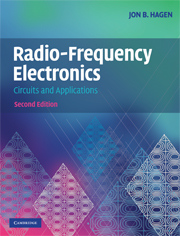Book contents
- Frontmatter
- Contents
- Preface
- 1 Introduction
- 2 Impedance matching
- 3 Linear power amplifiers
- 4 Basic filters
- 5 Frequency converters
- 6 Amplitude and frequency modulation
- 7 Radio receivers
- 8 Suppressed-carrier AM and quadrature AM (QAM)
- 9 Class-C, D, and E Power RF amplifiers
- 10 Transmission lines
- 11 Oscillators
- 12 Phase lock loops and synthesizers
- 13 Coupled-resonator bandpass filters
- 14 Transformers and baluns
- 15 Hybrid couplers
- 16 Waveguide circuits
- 17 Small-signal RF amplifiers
- 18 Demodulators and detectors
- 19 Television systems
- 20 Antennas and radio wave propagation
- 21 Radar
- 22 Digital modulation techniques
- 23 Modulation, noise, and information
- 24 Amplifier and oscillator noise analysis
- 25 The GPS Navigation system
- 26 Radio and radar astronomy
- 27 Radio spectrometry
- 28 S-parameter circuit analysis
- 29 Power supplies
- 30 RF test equipment
- Index
- References
8 - Suppressed-carrier AM and quadrature AM (QAM)
Published online by Cambridge University Press: 05 June 2012
- Frontmatter
- Contents
- Preface
- 1 Introduction
- 2 Impedance matching
- 3 Linear power amplifiers
- 4 Basic filters
- 5 Frequency converters
- 6 Amplitude and frequency modulation
- 7 Radio receivers
- 8 Suppressed-carrier AM and quadrature AM (QAM)
- 9 Class-C, D, and E Power RF amplifiers
- 10 Transmission lines
- 11 Oscillators
- 12 Phase lock loops and synthesizers
- 13 Coupled-resonator bandpass filters
- 14 Transformers and baluns
- 15 Hybrid couplers
- 16 Waveguide circuits
- 17 Small-signal RF amplifiers
- 18 Demodulators and detectors
- 19 Television systems
- 20 Antennas and radio wave propagation
- 21 Radar
- 22 Digital modulation techniques
- 23 Modulation, noise, and information
- 24 Amplifier and oscillator noise analysis
- 25 The GPS Navigation system
- 26 Radio and radar astronomy
- 27 Radio spectrometry
- 28 S-parameter circuit analysis
- 29 Power supplies
- 30 RF test equipment
- Index
- References
Summary
Viewed just in the time domain, ordinary AM, as used in broadcasting, seems so obvious that one would scarcely imagine how it might be done otherwise. But viewed in the frequency domain, as in Chapter 6, this system shows some obvious inefficiencies. First, most of the average transmitted power (about 95% when transmitting typical audio material) is in the carrier, which is a spike or “delta function” in the frequency domain. Since its amplitude and frequency are constant, it carries virtually no information. The information is in the sidebands. Could broadcasters just suppress the carrier to reduce their electric power costs by 95%? Second, the upper and lower sidebands are mirror images of each other, so they contain the same information. Could they not suppress (filter away) one sideband, making room for twice as many stations on the AM band? The answer to both questions is yes but, in both cases, the simple AM receiver, with its envelope detector, will no longer work properly. Economics favored the simplicity of the traditional AM receiver until it because possible to put all the receiver signal processing on an integrated-circuit chip, where the additional complexity can have negligible cost. In this chapter we examine alternate AM systems that remove the carrier and then at AM systems that reduce the signal bandwidth or double the information carried in the original bandwidth.
Double-sideband suppressed-carrier AM
Let us look at a system that removes the carrier at the transmitter and regenerates it at the receiver.
- Type
- Chapter
- Information
- Radio-Frequency ElectronicsCircuits and Applications, pp. 77 - 86Publisher: Cambridge University PressPrint publication year: 2009



